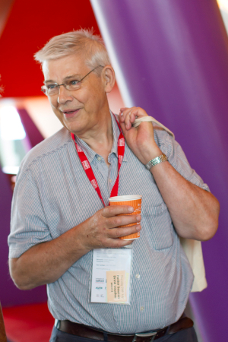
Keith at MH2014 in Manchester on 21st July 2014
An abridged version of this appears in the Preface to the MH2016 conference proceedings.
It was with great sadness that we learnt of the passing of Professor Keith Ross, aged 76, on 20th February 2016. Keith was a highly respected member of the metal hydride research community, and chaired the 14th International Symposium on Metal-Hydrogen Systems (MH2014) in Manchester, England. He made significant contributions to the development of neutron scattering techniques and their use for studying hydrogen behaviour in materials.
Keith was born in Co Antrim, Northern Ireland, on 16th July 1939. After reading Natural Sciences at the University of Cambridge, he obtained an MSc in Reactor Physics and Technology from the University of Birmingham. He began his scientific career at the UK Atomic Energy Authority at Winfrith Heath in Dorset, England, working on experimental sub-critical nuclear assemblies, developing neutron chopper techniques for measuring internal neutron spectra.
After three years at Winfrith Heath, he returned to Birmingham to work in the newly emerging field of neutron scattering. His early work there included construction of a neutron chopper facility at the Herald Reactor at AWRE, now AWE, in Aldermaston [1]; and he went on to build, with his first PhD students, a number of neutron scattering instruments, including a rotating crystal spectrometer and a double graphite monochromator chopper spectrometer [2]. Keith’s students from this period included Colin Carlile and Ian Anderson. Colin later became Director of the Institut Laue-Langevin (ILL) in Grenoble, France, and CEO of the European Spallation Source (ESS), which is currently being built in Lund, Sweden, while Ian served as Director of Neutron Sciences at Oak Ridge National Laboratory in the US.
Keith obtained a PhD in 1975 for his early work at Birmingham, and began to apply neutron scattering to hydrogen in metals. His studies in the 1970s included the use of quasi-elastic neutron scattering (QENS) to investigate hydrogen diffusion in PdHx [3], and analysis of inelastic neutron scattering (INS) spectra to correlate the optical vibrational frequencies of hydrogen to the metal-hydrogen distances in various systems, including VH1.92, NbH2 and TiH2, and their alloys [4]. He also applied QENS to other problems such as water diffusion in clays and went on to develop theories, with collaborators Peter Hall and Sunil Sinha, for analysing diffusion processes more generally from QENS data [5,6]. The Hall-Ross model, in particular, which describes restricted jump diffusion, is now included in standard neutron scattering data analysis software [7], and has been used to analyse diffusion in a diverse range of systems, including polymers and biological matter.
In 1985, Keith was awarded a DSc, and in 1989 he was appointed to a Readership. In the 1980s, with Mike Benham, he also developed the Intelligent Gravimetric Analyser (IGA), an instrument for precisely measuring both the equilibria and kinetics of hydrogen absorption and desorption by metals. Use of the IGA was first demonstrated on the Pd-H system [8] and it has now been used to measure hydrogen uptake by many different materials; however, it has also proved useful for measuring the sorption of other species, including both gases and condensable vapours. Hundreds of these instruments, later commercialised by Hiden Analytical in Warrington, England, are now installed worldwide, in universities, national laboratories and industrial R&D departments, and a dedicated company, Hiden Isochema, was formed in 2002 to further develop the technology.
In 1991, Keith moved to the University of Salford to take up a Chair in Physics. He went on to become Head of Physics and Director of the Institute for Materials Research at Salford. In the 1990s, he also began a long term collaboration with Ian Morrison that lasted until his retirement. At Salford, Keith continued studying hydrogen in metals, using various techniques, but maintained and developed his interest in other areas such as water adsorption and diffusion in porous materials, the dynamics of ice and oxygen behaviour in high Tc cuprate superconductors. Combining modelling and simulation with neutron scattering experiments was a particular focus of Keith’s work at this time, as illustrated by his use of first principles calculations, in collaboration with Ian Morrison, to analyse INS spectra from single crystal PdHx [9]. He also had a long-standing interest in using Monte Carlo lattice gas simulations, combined with QENS, to understand hydrogen diffusion in metals, and continued this work with Dan Bull at Salford. In parallel, he maintained his enthusiasm for developing neutron scattering techniques, and led the development, in the 1990s, of the OSIRIS diffractometer and polarisation analysis spectrometer at the ISIS neutron source near Oxford, England.
In the latter part of his career, Keith’s main interest was using neutron scattering to study hydrogen in potential hydrogen storage systems [10-14]. His work with Peter Georgiev and others, for example, used INS to study the rotational and translational dynamics of molecular H2 adsorbed in porous materials, such as carbon nanotubes [10], activated carbon [11] and zeolites [12], with the aim of identifying ways of increasing its interaction potential. He was involved in large European projects on hydrogen storage, such as HYTRAIN and NESSHY, but also led a recent UK project looking at the fundamentals of nuclear graphite.
Keith had varied interests throughout his career, making significant contributions in a number of fields, including neutron scattering and the study of metal-hydrogen interactions [14,15]. Many of his past students and postdocs now work at national and international neutron scattering facilities, as well as in academia and industry. His insight was often sought after and he maintained a number of external collaborations, with long term colleagues and friends, such as Peter Albers and Alan Oates. Keith will be remembered with great fondness by anyone who had the pleasure of working with him. He was an enthusiastic and supportive mentor and friend, and he will be sorely missed.
Darren Broom, July 2017
Back to the Hydrogen Storage Materials homepage